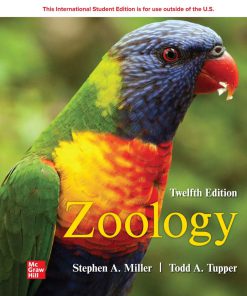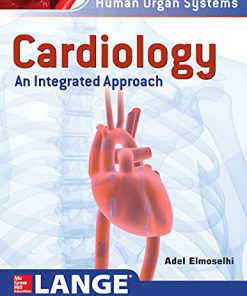Integrated Principles of Zoology 19th Edition by Cleveland P Hickman, Susan L Keen, David J Eisenhour, Allan Larson, Helen IAnson ISBN 9781264091218 1264091214
$50.00 Original price was: $50.00.$25.00Current price is: $25.00.
Integrated Principles of Zoology 19th Edition by Cleveland P Hickman, Susan L Keen, David J Eisenhour, Allan Larson, Helen IAnson – Ebook PDF Instant Download/Delivery: 9781264091218 ,1264091214
Full download Integrated Principles of Zoology 19th Edition after payment

Product details:
ISBN 10: 1264091214
ISBN 13: 9781264091218
Author: Cleveland P Hickman, Susan L Keen, David J Eisenhour, Allan Larson, Helen IAnson
Integrated Principles of Zoology 19th Edition Table of contents:
PART ONE
CHAPTER 1 Life: Biological Principles and the Science of Zoology
1.1 Fundamental Properties of Life
1.2 Zoology as a Part of Biology
1.3 Principles of Science
1.4 Theories of Evolution and Heredity
Summary
CHAPTER 2 The Origin and Chemistry of Life
2.1 Water and Life
2.2 Macromolecules
2.3 Chemical Evolution
2.4 Origin of Living Systems
2.5 Precambrian Life
Summary
CHAPTER 3 Cells as Units of Life
3.1 Cell Concept
3.2 Organization of Cells
3.3 Membrane Function
3.4 Mitosis and Cell Division
Summary
CHAPTER 4 Cellular Metabolism
4.1 Energy and the Laws of Thermodynamics
4.2 The Role of Enzymes
4.3 Enzyme Regulation
4.4 Chemical Energy Transfer by ATP
4.5 Cellular Respiration
4.6 Metabolism of Lipids
4.7 Metabolism of Proteins
Summary
PART TWO
CHAPTER 5 Genetics: A Review
5.1 Mendel’s Investigations
5.2 Chromosomal Basis of Inheritance
5.3 Mendelian Laws of Inheritance
5.4 Gene Theory
5.5 Storage and Transfer of Genetic Information
5.6 Gene Mutations
5.7 Molecular Genetics of Cancer
Summary
CHAPTER 6 Organic Evolution
6.1 Origins of Darwinian Evolutionary Theory
6.2 Darwinian Evolutionary Theory: The Evidence
6.3 Revisions of Darwin’s Theory
6.4 Microevolution: Genetic Variation and Change Within Species
6.5 Macroevolution: Major Evolutionary Events
Summary
CHAPTER 7 The Reproductive Process
7.1 Nature of the Reproductive Process
7.2 The Origin and Maturation of Germ Cells
7.3 Reproductive Patterns
7.4 Structure of Reproductive Systems
7.5 Endocrine Events That Orchestrate Reproduction
Summary
CHAPTER 8 Principles of Development
8.1 Early Concepts: Preformation Versus Epigenesis
8.2 Fertilization
8.3 Cleavage and Early Development
8.4 An Overview of Development Following Cleavage
8.5 Mechanisms of Development
8.6 Gene Expression During Development
8.7 Developmental Patterns in Animals
8.8 Evolutionary Developmental Biology
8.9 Vertebrate Development
8.10 Development of Systems and Organs
Summary
PART THREE
CHAPTER 9 Architectural Pattern of an Animal
9.1 Hierarchical Organization of Animal Complexity
9.2 Animal Body Plans
9.3 Components of Animal Bodies
9.4 Complexity and Body Size
Summary
CHAPTER 10 Taxonomy and Phylogeny of Animals
10.1 Linnaeus and Taxonomy
10.2 Species
10.3 Taxonomic Characters and Phylogenetic Reconstruction
10.4 Theories of Taxonomy
10.5 Major Subdivisions of the Animal Kingdom
Summary
CHAPTER 11 Unicellular Eukaryotes
11.1 Naming and Identifying Unicellular Eukaryotic Taxa
11.2 Form and Function
11.3 Nutrition and Digestion
11.4 Excretion and Osmoregulation
11.5 Reproduction and Life Cycles
11.6 Major Unicellular Eukaryotic Taxa
11.7 Phylogeny and Adaptive Diversification
Summary
CHAPTER 12 Sponges and Placozoans
12.1 Origin of Animals
12.2 Phylum Porifera: Sponges
12.3 Form and Function in Sponges
12.4 Survey of Sponges
12.5 Phylum Placozoa
Summary
CHAPTER 13 Cnidarians and Ctenophores
13.1 Phylum Cnidaria
13.2 Form and Function
13.3 Survey of Cnidarians
13.4 Phylum Ctenophora
13.5 Phylogeny and Adaptive Diversification
Summary
CHAPTER 14 Xenacoelomorpha, Platyhelminthes, Gastrotricha, Gnathifera, and Mesozoa
14.1 Phylum Xenacoelomorpha
14.2 Clades Within Protostomia
14.3 Phylum Platyhelminthes
14.4 Phylum Gastrotricha
14.5 Clade Gnathifera
14.6 Phylum Gnathostomulida
14.7 Phylum Chaetognatha
14.8 Phylum Micrognathozoa
14.9 Phylum Rotifera
14.10 Phylum Acanthocephala
14.11 Phylum Mesozoa
14.12 Phylogeny
Summary
CHAPTER 15 Polyzoa and Trochozoa
15.1 Clade Polyzoa
15.2 Phylum Cycliophora
15.3 Phylum Entoprocta
15.4 Phylum Ectoprocta (Bryozoa)
15.5 Clade Trochozoa
15.6 Clade Brachiozoa
15.7 Phylum Brachiopoda
15.8 Phylum Phoronida
15.9 Phylum Nemertea (Rhynchocoela)
15.10 Phylogeny
Summary
CHAPTER 16 Molluscs
16.1 Molluscs
16.2 Form and Function
16.3 Classes of Molluscs
16.4 Phylogeny and Adaptive Diversification
Summary
CHAPTER 17 Annelids
17.1 Phylum Annelida, Including Pogonophorans (Siboglinids), Sipunculans, and Echiurans
17.2 Errantia
17.3 Sedentaria
17.4 Clade Clitellata
17.5 Evolutionary Significance of a Coelom and Metamerism
17.6 Phylogeny and Adaptive Diversification
Summary
CHAPTER 18 Smaller Ecdysozoans
18.1 Phylum Nematoda: Roundworms
18.2 Phylum Nematomorpha
18.3 Phylum Loricifera
18.4 Phylum Kinorhyncha
18.5 Phylum Priapulida
18.6 Clade Panarthropoda
18.7 Phylum Onychophora
18.8 Phylum Tardigrada
18.9 Phylogeny and Adaptive Diversification
Summary
CHAPTER 19 Trilobites, Chelicerates, and Myriapods
19.1 Phylum Arthropoda
19.2 Subphylum Trilobita
19.3 Subphylum Chelicerata
19.4 Subphylum Myriapoda
19.5 Phylogeny and Adaptive Diversification
Summary
CHAPTER 20 Crustaceans
20.1 Subphylum Crustacea
20.2 A Brief Survey of Crustaceans
20.3 Phylogeny and Adaptive Diversification
Summary
CHAPTER 21 Hexapods
21.1 Classes Entognatha and Insecta
21.2 External Form and Function
21.3 Internal Form and Function
21.4 Metamorphosis and Growth
21.5 Behavior and Defense
21.6 Insects and Human Welfare
21.7 Phylogeny and Adaptive Diversification
Summary
CHAPTER 22 Echinoderms and Hemichordates
22.1 Clade Ambulacraria
22.2 Phylum Echinodermata
22.3 Phylogeny and Adaptive Diversification of Echinoderms
22.4 Phylum Hemichordata
22.5 Phylogeny and Adaptive Diversification of Hemichordates
Summary
CHAPTER 23 Chordates
23.1 Ancestry and Evolution of the Chordates
23.2 Five Chordate Characteristics
23.3 Subphylum Tunicata (Urochordata)
23.4 Subphylum Cephalochordata
23.5 Subphylum Vertebrata
Summary
CHAPTER 24 Fishes
24.1 Ancestry and Relationships of Major Groups of Fishes
24.2 Cyclostomata: Living Jawless Fishes
24.3 Chondrichthyes: Cartilaginous Fishes
24.4 Osteichthyes: Bony Fishes and Tetrapods
24.5 Structural and Functional Adaptations of Fishes
Summary
CHAPTER 25 Early Tetrapods and Modern Amphibians
25.1 Devonian Origin of Tetrapods
25.2 Temnospondyls and Modern Amphibians
25.3 Caecilians: Order Gymnophiona (Apoda)
25.4 Salamanders: Order Urodela (Caudata)
25.5 Frogs and Toads: Order Anura (Salientia)
Summary
CHAPTER 26 Amniote Origins and Nonavian Reptiles
26.1 Origin and Early Evolution of Amniotes
26.2 Changes in Traditional Classification of Reptiles
26.3 Characteristics and Natural History of Reptilian Groups
Summary
CHAPTER 27 Birds
27.1 Origin and Relationships
27.2 Structural and Functional Adaptations for Flight
27.3 Flight
27.4 Migration and Navigation
27.5 Social Behavior and Reproduction
27.6 Bird Populations and Their Conservation
Summary
CHAPTER 28 Mammals
28.1 Origin and Evolution of Mammals
28.2 Structural and Functional Adaptations of Mammals
28.3 Mammals and Their Environments
28.4 Humans and Mammals
28.5 Human Evolution
Summary
PART FOUR
CHAPTER 29 Support, Protection, and Movement
29.1 Integument
29.2 Skeletal Systems
29.3 Animal Movement
Summary
CHAPTER 30 Homeostasis: Osmotic Regulation, Excretion, and Temperature Regulation
30.1 Water and Osmotic Regulation
30.2 Invertebrate Excretory Structures
30.3 Vertebrate Kidney
30.4 Temperature Regulation
Summary
CHAPTER 31 Homeostasis: Internal Fluids and Respiration
31.1 Internal Fluid Environment
31.2 Composition of Blood
31.3 Circulation
31.4 Respiration
Summary
CHAPTER 32 Digestion and Nutrition
32.1 Feeding Mechanisms
32.2 Digestion
32.3 Organization and Regional Function of Alimentary Canals
32.4 Regulation of Food Intake
32.5 Nutritional Requirements
Summary
CHAPTER 33 Nervous Coordination: Nervous System and Sense Organs
33.1 Neurons: Functional Units of Nervous Systems
33.2 Synapses: Junctions Between Nerves
33.3 Evolution of Nervous Systems
33.4 Sense Organs
Summary
CHAPTER 34 Chemical Coordination: Endocrine System
34.1 Mechanisms of Hormone Action
34.2 Invertebrate Hormones
34.3 Vertebrate Endocrine Glands and Hormones
Summary
CHAPTER 35 Immunity
35.1 Susceptibility and Resistance
35.2 Innate Defense Mechanisms
35.3 Immunity in Invertebrates
35.4 Acquired Immune Response in Vertebrates
35.5 Blood Group Antigens
Summary
CHAPTER 36 Animal Behavior
36.1 Describing Behavior: Principles of Classical Ethology
36.2 Control of Behavior
36.3 Social Behavior
Summary
PART FIVE
CHAPTER 37 Animal Distributions
37.1 Principles of Historical Biogeography
37.2 Distribution of Life on Earth
Summary
CHAPTER 38 Animal Ecology
38.1 The Hierarchy of Ecology
38.2 Populations
38.3 Community Ecology
38.4 Ecosystems
38.5 Extinction and Biodiversity
Summary
Appendix A: Cladogram of All Animal Phyla
Appendix B: Timeline of Major Biological Events
Glossary
Index
People also search for Integrated Principles of Zoology 19th Edition:
laboratory studies in integrated principles of zoology pdf
laboratory studies in integrated principles of zoology 19th edition
integrated principles of zoology 19th edition
integrated principles of zoology 18th edition
integrated principles of zoology ucf
Tags: Cleveland P Hickman, Susan L Keen, David J Eisenhour, Allan Larson, Helen IAnson, Zoology
You may also like…
Engineering - Electrical & Electronic Engineering
Biology and other natural sciences - Virology
Cann’s Principles of Molecular Virology (Seventh Edition) Edward P. Rybicki
Biology and other natural sciences - Zoology
Biology and other natural sciences - Biology
Biology and other natural sciences
Medicine - Cardiology
Cardiology-An Integrated Approach 1st Edition by Elmoselhi 9780071791557 0071791558
Children's Books - Animals
Biology and other natural sciences - Zoology











